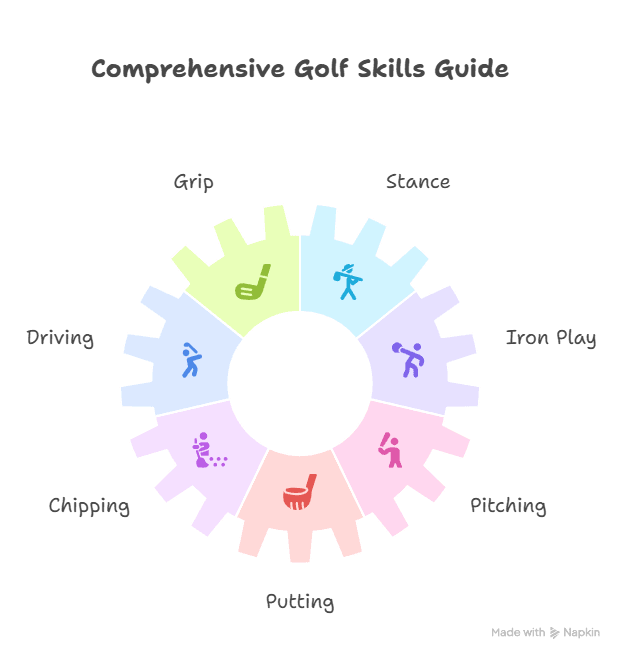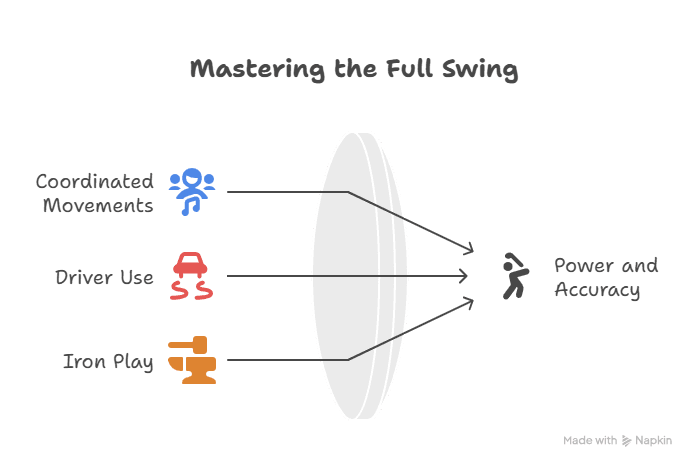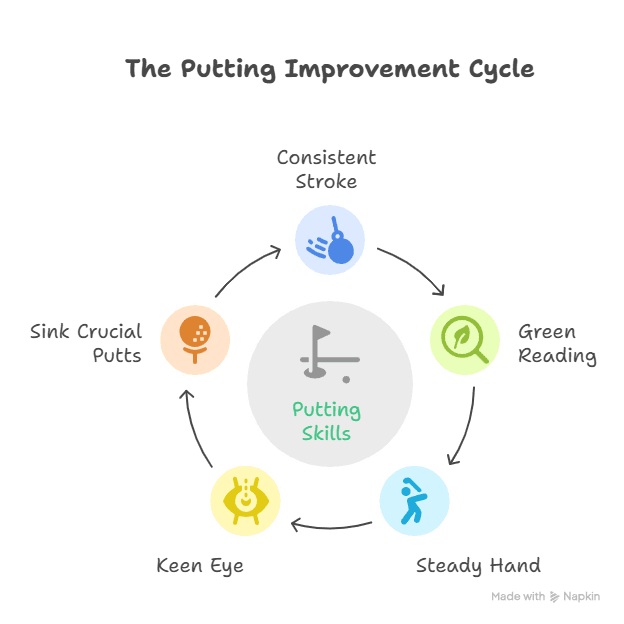Top Takeaways and Key Concepts
→ Master your golf fundamentals by focusing on grip, stance, and balanced posture for consistent swings.
→ Perfect your swing rhythm using proper hip rotation, timing, and visualization to improve accuracy.
→ Develop your short game through putting drills and reading greens to lower your score.
→ Play strategically by managing risks, selecting the right clubs, and thinking ahead on each hole.
→ Strengthen your mental game with visualization, positive self-talk, and calm breathing under pressure.
Summary of This Article
This article explores how mastering golf fundamentals, swing rhythm, and mental focus can elevate your game. It highlights the importance of grip, stance, visualization, and course strategy in building confidence and precision. With consistent practice and a positive mindset, golfers can improve performance, enjoy the process, and play with more control and consistency.
Video Summary
Please Note: This post may contain affiliate links. If you click one of them, we may receive a commission at no extra cost to you. As an Amazon Associate, I earn from qualifying purchases.
Golf is a game that requires skill, patience, and a little bit of frustration. You might have wondered, “How do they make it look so easy?” if you've ever seen a pro golfer swing their club with grace and ease. It's all about learning the basics of golf basics, my friend! Let's look at the world of golf and see how you may have fun while getting better at the game.
Understanding the Basics of Golf Skills

“Golf is a game of precision and patience. Master the basics, and the rest will follow.” – Jack Nicklaus
First, what are golf skills? You might think of them as the parts that make up this great game. They cover everything from how to hold the club and stand to how to swing and putt. Once you get the feel of it, you'll be cruising down the fairway in no time, just like riding a bike.
Let's talk about grip now. Have you ever tried to shake hands with someone who doesn't have a strong grip? It's weird, isn't it? Your golf club is the same way. To control your shots, you need to have a good grip. You want to grasp it tightly, but not like you're trying to crush an apple. I mean, we're here to play golf, not sell fruit!

Your position is just as crucial. Imagine this: you're trying to keep a stack of books on your head while standing on one leg. Sounds hard? If your stance is off, that's how it feels! You know that balance is key if you've ever attempted yoga or dance. Now, picture trying to hit a golf ball without the appropriate footing. It's like trying to prepare spaghetti while on a rollercoaster; it's just not going to work out!
You should stand with your feet shoulder-width apart when you get ready to shoot. This offers you a solid base, like having a strong grip on the ground below you. When superheroes are ready to fight, they stand with their legs firmly planted and ready to move. This foot stance will provide you more stability, which will help you transfer your weight better during your swing.
Let's talk about those knees now. It may not seem like a big deal to keep them slightly bent, but it makes a big impact! Think of yourself like an athlete, ready to react at any moment. This small bend helps you stay flexible and balanced while you follow through with your swing. You don't want to be stiff like a board; instead, you want to be flexible so you can move naturally.
Swing Speed vs. Distance: Many people think that swing speed is the only thing that affects how far you can drive, but studies show that a well-timed and coordinated swing can frequently send the ball farther than just pure power. Golfers who swing more slowly can hit great distances by focusing on their technique and body mechanics.
The Mental Game Matters: Studies show that as much as 90% of golf is mental, not physical. Using visualization, talking to yourself in a good way, and being focused can all help you play better on the course. Players can enhance their physical talents and mental toughness by understanding this part of the game. This makes the game more fun and helps them do better.
And speaking of moving, have you ever noticed how golfers look almost beautiful when they set up their shots? That's because they're also using their core muscles. A strong core gives you more support, which helps you keep your balance during the swing. It might seem foolish at first, but try moving around a little bit before you shoot. It gets your body ready for action and makes things less tense.
In summary, getting the right stance isn't just about looking good on the course (though let's be honest, we all want that). It's all about setting the stage for the next swing. If you practice and pay attention to these basics, you'll be able to swing with style and confidence—maybe even become a superhero along the way!
Perfecting Your Swing Technique

“The swing is the thing. You can’t get to where you want to go if you don’t have the right swing.” – Ben Hogan
Now that we know how to hold the club and stand, let's get to the big question: how do I swing like Tiger Woods? There isn't a magic wand; you just have to practice!
Timing and rhythm are two of the most important parts of a successful swing. Think about hitting a bat at baseball; it's all about getting into the swing of things. When I initially started playing golf, my swings looked more like windmills than anything else! But with time, I discovered that starting slowly helps you get going.
A lot of people make the mistake of thinking too much about every small thing while they swing. I mean, we've all been in that situation, right? Standing on the tee box, holding the club like it's a life preserver, and going over a mental checklist that may be as long as a NASA launch sequence. You're thinking about everything beyond hitting the ball, like how to hold it, how to stand, and the angle of your elbows. Instead of trying to smash the ball hard (which typically ends badly), try to picture where you want it to go instead.

You know how people say that sometimes less is better? This is one of those times. It helps to take some of the strain off when you start to see that perfect shot—a lovely arc flying through the air toward the green. Just picture yourself on a sunny fairway with birds singing and maybe even a happy squirrel cheering you on. Instead of worrying about every little thing about your swing, try to focus on the goal. This will help you relax your mind and body.
But if envisioning yourself as Rory McIlroy doesn't help much—let's be honest, not everyone can pull off his easygoing style—maybe just aim for the nearest bush! Really! Sometimes making things simpler can have surprisingly good results. Why not set a modest target instead of worrying about whether you're holding your club correctly or following through perfectly? When you aim for that bush, you're still aiming for something particular without becoming stuck in the minutiae.
The Hips' Role: A lot of golfers just pay attention to their arms and shoulders when they work on their swing, but research has shown that the hips are quite important for getting power and accuracy. Proper hip rotation may add a lot of distance to drives because it helps the lower body transfer energy to the upper body more efficiently during the swing.
And here's another idea: if you stop worrying about being flawless and just try to hit the ball and aim for something fun, you could discover that you swing more naturally. It feels like you're playing a game! Who would have thought golf could be so fun? Imagine that you hit a shot at that bush and suddenly feel like you've climbed Mount Everest because you didn't let your nerves get in the way.
So, the next time you're getting ready to swing, take a deep breath and picture where you want the ball to fall. Keeping things lighthearted can make a big difference in how much you enjoy your game, whether you land softly on the green or curve around a tree (or crash into that neighboring brush). Along the way, you might hit some spectacular shots!
Short Game Skills: Putting Like a Pro

“Golf is a game of inches. The closer you get to the hole, the more important your short game becomes.” – Jack Nicklaus
Ahh, putting—the part of golf that can either make or break your scorecard faster than you can say “fore!” It's often said that putting accounts for nearly half your strokes during a round. So why not master this skill?
First off, let’s discuss distance control because nobody likes overshooting the hole by three feet (or worse). To practice this skill effectively at home or on the course—try varying distances with each putt while maintaining focus on speed rather than power.
Also interestingly enough, reading greens is an art form in itself! Have you ever noticed how some golfers stare at the ground like they're deciphering ancient hieroglyphics? Seriously, it’s almost like they’re trying to crack a secret code that only seasoned pros understand. These players lean down, squint their eyes, and tilt their heads as if they’re examining a rare artifact from a lost civilization. But really, what they’re doing is figuring out the slopes and breaks of the green—an essential skill for sinking those crucial putts.

Understanding these subtle nuances can make all the difference between a triumphant birdie and a frustrating three-putt. Think about it: every green has its own personality. Some are smooth and flat, while others have bumps and dips that could rival a roller coaster ride! It’s kind of like trying to read a map where X marks the spot; if you don’t know which way the terrain goes, you might end up wandering off course or worse yet, missing your target entirely.
When you're standing over that ball on the green, take a moment to look around. Is there a slight slope to your left? A sneaky little dip to your right? Maybe even a ridge that looks innocent but will send your ball veering off course if you’re not careful? By visualizing how gravity will affect your putt, you're setting yourself up for success—or at least reducing the chances of becoming one with that dreaded sand trap nearby.
But here's where it gets even more intriguing: different grass types can affect how fast or slow your ball rolls. You might think it's just grass, but oh no! There’s Bermuda grass versus bentgrass—sounds fancy, doesn’t it? Each type behaves differently under various weather conditions too. So when you see those golfers deep in thought on the putting green, they aren’t just daydreaming about their next vacation; they’re calculating how to navigate this intricate puzzle laid out before them.
And let’s not forget about reading the grain of the grass! This is where things get really fun (or maddening). The grain refers to the direction in which the grass grows; it can either speed up or slow down your ball depending on which way you hit it. If you've ever seen someone miss an easy putt by inches because they didn't account for this tiny detail—you know exactly what I mean!
Seeing Success: Many professional golfers employ visualization exercises before they putt. Studies show that mentally going over the path of the ball to the hole can improve play by making neural pathways in the brain that are comparable to those made by physical practice. This mental preparation can help you feel more sure of yourself and hit the ball more accurately on the greens.
So next time you find yourself staring at those mysterious lines on the green like you're preparing for an episode of “CSI: Golf Course Edition,” remember that practice makes perfect. Spend some time honing this skill—it’ll pay off big time when you're lining up those crucial putts during your next round. After all, mastering reading greens isn’t just another trick in your bag; it’s practically an invitation to become part of golf's elite club!
And remember—stay calm! If there's one thing I've learned from watching my friends miss easy putts—it’s that panicking never helps anyone sink that ball into the hole!
Developing Course Management Skills
“Golf is not about how good you are; it’s about how well you manage your game.” – Unknown
You might assume that golf is only about striking balls as far as you can, but hold on! There are also strategic skills that are part of course management. This involves learning when to take chances and when it's best to stay safe.
For example, should I try that wild shot over the water hazards or lay up short? You need to plan ahead when making choices like this. It's like deciding whether or not to have dessert before dinner (hint: always choose dessert!).
Knowing which clubs work best in certain conditions might also help you save strokes. You are on the fairway with 150 yards to go to the hole, and all you need is a par to keep your score from going down. Wouldn't it be a little foolish to pull out your driver now? That gleaming club looks great, but using it here could be like taking a bazooka to a pillow fight—too much!

Sometimes skill is better than strength. Golf isn't only about hitting the ball as hard as you can; it's also about planning and making wise choices. If you have to make a delicate approach shot over water or around trees, using a more accurate club, such an 8-iron or even a pitching wedge, might be the best thing you can do. These clubs provide you more control and accuracy, so you can hit the ball exactly where you want it instead of sending it into the drink.
Now let's speak about the hard lies we typically find on the course. You know, the ones where your ball seems to have found a home in a patch of grass that doesn't want it or next to a rock? In certain situations, knowing which club to use can mean the difference between making par and having to call for help (extra strokes). A lob wedge might help you get out from under those annoying branches while still providing you enough height to get over things.
And what about when the wind is blowing? Oh indeed, Mother Nature's little prankster! When the wind is screaming through the course like it's trying out for a part in “Twister,” it's even more important to use the appropriate club. A mid-iron shot that is hit correctly might cut through the wind far better than a big driver that is just swinging about in the wind. It's all about being flexible and making smart choices based on what's going on right now.
The 90% Rule: Research shows that a golfer's course management choices can account for up to 90% of their score, not just their skill. This shows how important it is to think strategically, such knowing when to play aggressively or defensively based on your skills and weaknesses.
But here's something else to think about: sometimes less distance is better. A lot of golfers make the mistake of assuming that every stroke has to go as far as possible. The truth is that knowing what you can and can't do is quite important. If you don't feel good about your driver today because you've been having trouble with slices or hooks, why not play it safe? Instead of feeling bad about your shot every time you step up, use something different that offers you more control and makes you feel good about it.
So the next time you're on the course and have to choose which club to use, take a moment to breathe deeply and think about your options. Golf requires both mental and physical skill. You can save strokes and gain confidence in your game overall by learning how different clubs work in different conditions. And who doesn't want to leave that green feeling like they've just climbed their own Mount Everest?
Staying Mentally Strong on The Course
“The most important shot in golf is the next one.” – Ben Hogan
Golf is more than simply a sport; it's the best way to work out your mind! When you're faced with tricky shots or sudden changes in the weather (like wind!), it's important to be calm.
I learned a secret from a lot of pros: they utilize visualization techniques before they make their shot. It really helps calm my anxiety! Have you ever seen a professional golfer on TV? They don't just walk up to the ball and swing wildly; they take a moment to get ready. They seem to be tuned into their own mental radio station, where the songs are all about making perfect shots. This isn't just for show; it's a strong tool that can assist even us normal people get into the flow.
So, what is this whole business about visualizing? Okay, let's take it apart. Before you hit the ball, close your eyes for a second (but not too long—you don't want to fall asleep while you're swinging!). Picture yourself hitting that perfect drive down the fairway, feeling the sun on your face and hearing the wonderful *thwack* when the club hits the ball. It's like you're the main character in a golf movie that you make up in your imagination. The most important thing is to truly dig into those details—how does it feel when everything comes together? What do you see? What do you hear?
If you're anything like me, you could get a little too into the details. Imagine this: you're driving fast while drinking lemonade amid palm trees… If you're not at Pebble Beach, you might want to skip those last two details. But really, thinking about good things can change your mind from being anxious to being confident. Instead of fretting about what might go wrong, like putting the ball onto a nearby fairway or worse, a little mental practice might help you remember what it feels like to succeed.
This method is interesting because it doesn't just work on the tee box. You can use visualization at any time during the game! Imagine that you're getting ready to make a hard putt and everyone is watching you. Think about the direction the ball will take as it rolls toward the hole for a moment. Picture it slowly going past any obstructions and then sinking right in there—BOOM! Nothing except the net! This kind of focused thought gets rid of doubt and lets you trust your gut.
And speaking of intuition, have you ever seen how certain golfers stay calm when the pressure is on? That's typically because they've done these visualization exercises so many times that they come naturally to them. It's like having a coach inside you who murmurs encouraging things to you and gives you high-fives along the way. When things get tough on the course, as when they need a birdie on the last hole, they use this mental imagery instead of allowing their nerves control how well they play.
Breathing Exercises: Research shows that controlled breathing can help you focus and lower your stress levels as you play. Researchers have shown that practicing deep, regular breathing can drop heart rates and soothe nerves, which helps golfers stay calm under pressure.
I should also say that just visualizing won't make you Tiger Woods overnight (if only!). You still need to practice and improve your skills along with these mental tactics. But really, using good technique and great visuals together may make a huge difference in your game.
So the next time you're getting ready to take a shot, whether it's off the tee or from behind a tree to save par, take a few seconds to picture yourself succeeding first. It will not only help you relax, but it will also help you get better results overall. And who knows? You might one day share stories about how visualizing changed your golf game while you relax under real palm trees at Pebble Beach!
Staying positive is also very important, because even pros miss simple putts from time to time! Instead of thinking about the mistakes you made earlier in the round, think about why you love playing golf.
Continuous Improvement Through Practice
It takes determination to accomplish anything well, and yeah, I'm talking about practice here! It may sound like a cliché, but investing time working on certain talents pays off big time later on!
Think about putting up specific periods each week to work on different things, like how accurate your driving is or how consistent your chipping is. It will be less overwhelming than attempting to do everything at once.
But here's something interesting: you don't necessarily require expensive courses. Many local parks offer open places where you may practice your swings without spending a lot of money.
But all things considered, the more time and effort you put into improving your golf skills, the more fun you'll have playing with friends and family.
Featured Snippet: Improving your golf game starts with mastering the basics — grip, stance, and balance. Combine consistent swing rhythm, strong mental focus, and smart course strategy to enhance control and confidence. With steady practice, patience, and visualization, any golfer can play with greater precision and enjoyment on the course.
Frequently Asked Questions
What are the most important fundamentals in golf?
The key fundamentals include a solid grip, proper stance, balanced posture, and consistent swing rhythm. These build a strong foundation for accuracy and control.
How can I improve my golf swing consistency?
Focus on rhythm and body coordination rather than speed. Practice controlled hip rotation and visualize each shot to improve timing and precision.
Why is mental focus important in golf?
Golf is largely mental—visualization, self-talk, and calm breathing help maintain confidence and focus under pressure, improving both form and results.
What’s the best way to practice putting effectively?
Practice from varying distances and focus on reading greens carefully. Aim to control speed, not power, to refine distance and accuracy.
How does course management affect a golfer’s score?
Strategic play—like selecting the right club and knowing when to take risks—can prevent costly mistakes and lower scores.
How often should I practice to see improvement?
Set aside specific weekly practice sessions to focus on different skills, from driving to short game control, for steady, lasting progress.
What’s the best way to handle pressure on the golf course?
Use visualization and steady breathing to stay calm. Focus on one shot at a time and keep a positive mindset, even after mistakes.
Suggested External Resources:
Golf Digest
https://www.golfdigest.com/
PGA Tour Tips
https://www.pgatour.com/tips.html
USGA Rules
https://www.usga.org/rules.html
Golf Channel Instruction
https://www.golfchannel.com/instruction
Topgolf Blog
https://topgolf.com/us/blog/

Kevin Collier is an avid golfer and contributing author at AIGolfTips.com, where he shares his passion for the game through expert tips, techniques, and gear reviews. With years of experience on the course, Kevin offers valuable insights for golfers of all skill levels, helping them improve their game and maximize their potential. Whether discussing swing mechanics or the latest in golf technology, Kevin's engaging approach aims to inspire and educate fellow golf enthusiasts to elevate their performance and enjoy every moment on the green.





